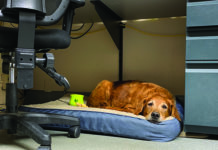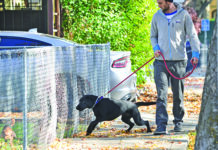Why Do Dogs Roll in Stinky Things?! And What Can You Do About It?
The walk starts innocently enough. Then you realize your dog, who has scampered ahead of you, has hit the ground and is writhing gleefully...
Dogs in the Workplace Company Profile: On-Site LaserMedic
On-Site LaserMedic is a dog-friendly laser printer repair company in Chatsworth, California. Roxanna Sanchez, the organization’s chief operating officer, has been bringing her dogs...
Dogs in the Workplace
As the saying goes, “Life is better when I’m with my dog.” I can cite a long list of ways that he makes my days...
Reforming a Reactive Dog
We’ve all seen them – those nightmare dogs who lunge, leap, growl, snarl, snap, bark, threaten, bare their teeth, act like bullies, and charge...
Frustrated On Leash?
You’ve probably seen them. Maybe you even have one – a dog who happily plays with his canine pals in the dog park, but...
Understanding Your Dog’s Nose
All dogs have noses – and they all know how to use them. Our awareness of our dog’s nose capabilities is nothing new. We...
Confidence Lost
When Woody (my three-year-old pit bull-mix) was a tiny puppy, just another one in a litter of nine that I was fostering for my...
Dog Kisses: Is Your Dog Really Kissing You?
You either love it or hate it: the wet, warm sensation of a dog licking your face. Many of us seek out this kind...
Welcome to the new Whole Dog Journal website!
We’re pleased to present to you Whole Dog Journal’s
brand-new website. On the site, you’ll find every article we’ve ever published,
going back to our first...
Highs and Lows
Nova’s placement is also a win for WDJ, since she’s a smart, well-behaved dog and her mom’s proximity and training acuity means they can model and demonstrate for articles in the magazine, often, I hope! Working with them has definitely been one of the highlights of putting this issue together.
What Causes Aggressive Dog Behavior?
When dogs display aggressive behaviors, it’s rare for humans to consider whatever the dog was trying to communicate. Instead, the behaviors are just considered unacceptable, threatening, and dangerous. Look at it from their point of view, though.
Does Your Female Dog Hump?
Usually humping is associated with male dogs, but humping is also very common amongst female dogs. Some girls will hump toys or other objects, some hump air, others hump other dogs or even people. To learn more about humping, why girls do it, and how to keep your female dog from humping, we talk with Certified Professional Dog Trainer and Chair of The Association of Professional Dog Trainers Nick Hof, CPDT-KA, CBCC-KA, KPA-CTP, CSAT, to answer some of your most commonly asked questions about female dogs and humping.


















